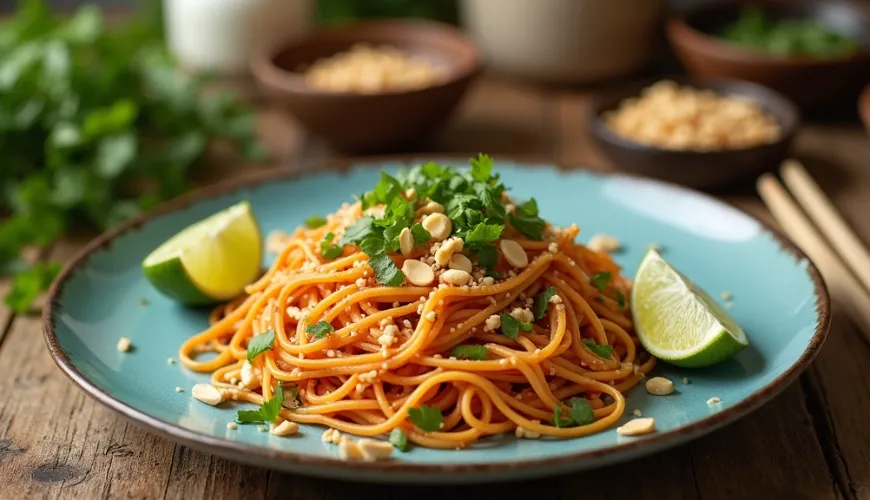
How to Make an Authentic Pad Thai Recipe Even with Common Ingredients

What is Pad Thai and Why Has it Become a Global Phenomenon?
Pad Thai is one of the most famous and popular dishes of Thai cuisine, which has won millions of fans worldwide — and the Czech Republic is no exception. Although this dish has its roots in Southeast Asia, today it can be found on menus around the world and increasingly in home kitchens. It's no wonder — the combination of rice noodles, sweet and sour sauce, crispy peanuts, and fresh herbs offers a harmony of flavors that is hard to compete with.
However, Pad Thai is not just another "Asian fried noodle." It has its history and cultural significance, linked to Thailand's effort to unify national identity during World War II. The government at the time promoted recipes that used local ingredients, were cheap and nutritious — and Pad Thai became a symbol of this effort. Today, you can prepare this iconic delicacy at home with an easy Pad Thai recipe that doesn't require exotic ingredients or hours in the kitchen.
What Constitutes an Authentic Pad Thai Recipe?
At first glance, it might seem that Pad Thai requires a lot of unusual ingredients. The truth is, most of them are commonly available today in well-stocked supermarkets or specialized Asian food stores. The basics are rice noodles, quality sauce, fresh herbs, and some source of protein — most commonly chicken, shrimp, or tofu.
A typical Pad Thai recipe with chicken includes:
- 200 g rice noodles
- 2 tablespoons oil (preferably sesame or peanut)
- 2 cloves of garlic
- 1 medium onion
- 250 g chicken breast, sliced thinly
- 2 eggs
- 100 g mung bean sprouts
- 1 handful of spring onions for garnish
- 2 tablespoons chopped peanuts
- Lime for seasoning
What elevates Pad Thai from a common dish to a gastronomic experience is primarily the Pad Thai sauce. Its recipe can have various variations, but generally, it should balance four basic flavors — sweet, salty, sour, and spicy. Traditional Pad Thai sauce is made from:
- 2 tablespoons fish sauce
- 2 tablespoons tamarind paste (or lime juice as an alternative)
- 1 tablespoon cane sugar
- 1 teaspoon chili (to taste)
All these ingredients are mixed in a pan and briefly simmered until the sugar dissolves and the sauce thickens. The result is a sticky, aromatic liquid that gives the noodles their characteristic taste. If you don't have tamarind on hand, you can improvise — a combination of lime juice and a bit of apple cider vinegar will do a similar job. Similarly, fish sauce can be replaced with soy sauce if you're preparing a vegetarian version.
How to Prepare Pad Thai Step by Step
Preparing Pad Thai at home might seem a bit complicated, but it's actually not rocket science — you just need to have everything nicely prepared in advance because once you turn on the pan, the whole process goes at lightning speed. The first step? Rice noodles — prepare them according to the instructions on the package, whether you boil them or just soak them, the main thing is that they are ready and nicely drained, set aside for use.
Meanwhile, heat the oil in a larger pan or ideally in a wok, toss in the chopped garlic and onion, and briefly sauté them until they start to smell. Into this fragrant base comes the chicken — cut into pieces and fried to a golden color so that it has a nice color and taste. Now push the chicken to the side of the pan and crack the eggs into the empty space — stir until a scrambled, opaque mixture forms.
In come the noodles, which you transfer to the pan and immediately pour with the prepared Pad Thai sauce, so it absorbs into every piece. Mix everything well to combine the flavors, and finally, add the fresh sprouts — but just lightly heat them so they remain crunchy. And it's done! On the plate, garnish the whole dish with chopped peanuts, spring onions, and ideally a wedge of lime, which gives it a fresh finish.
Many chefs recommend adding fresh coriander, chili flakes, or a bit of coconut sugar if you want to adjust the taste further. The result should be gently sweet, slightly spicy, with a pronounced lime acidity and umami from the fish sauce — just like it tastes on the streets of Bangkok.
Pad Thai in Czech Cuisine - How to Adapt the Recipe According to Ingredients
Although an authentic Pad Thai recipe works with ingredients that are sometimes not readily available, there's no reason to give up preparing it. It can be easily adjusted according to availability or personal preferences. If, for example, you don't have mung bean sprouts, you can replace them with radish sprouts or finely chopped white cabbage. Tamarind paste can be replaced with lime juice and a bit of apple cider vinegar. Instead of chicken, tofu, tempeh, or shrimp can be used — just add them towards the end of frying to keep them juicy.
An interesting example is offered by Mrs. Alena from Prague, who started preparing Pad Thai at home during the lockdown. "At first, I was afraid it would be too complicated — some ingredients I didn't even know. But in the end, I managed with common ingredients. And now we make it at home every month," she says with a smile. Her version with zucchini noodles and tofu has become a family hit.
Another option is to prepare Pad Thai without meat and instead enrich it with vegetables — for example, carrot, zucchini, bell pepper, or spring onion. Such a vegetarian Pad Thai recipe not only suits a plant-based diet better but is also lighter and ideal for a summer dinner.
Why Do Nutrition Specialists Love Pad Thai?
One of the reasons why Pad Thai is gaining popularity not only among gourmets but also among adherents of a healthy lifestyle is its nutritional balance. It contains all the main components — proteins (from meat, tofu, or eggs), carbohydrates (from noodles), fiber (from sprouts and vegetables), and healthy fats (from peanuts). It also satisfies well and, thanks to the ability to control the amount of oil and sugar, can be prepared in a lighter version.
Moreover, if you use brown rice noodles or gluten-free variants, Pad Thai is also suitable for people with celiac disease or gluten sensitivity. The trick is to find the right balance between taste and nutritional value — and Pad Thai allows for this flexibility.
A more sustainable version is created if you opt for local ingredients — for example, using Czech organic vegetables, eggs from local farms, or locally produced tofu. And although peanuts or tamarind cannot be entirely local, their amount in the recipe is minimal and can be considered "allowed exceptions" in the name of an authentic experience.
As the renowned American chef Andy Ricker, who has opened several restaurants in the USA focused solely on Thai cuisine, says: "Pad Thai is like jazz — it has its firm foundations, but the best versions arise when you let yourself be carried away by improvisation."
And that's precisely where the magic of this dish lies. You can adjust it to suit your taste, diet, and season — and yet it always offers an exceptional flavor harmony.

